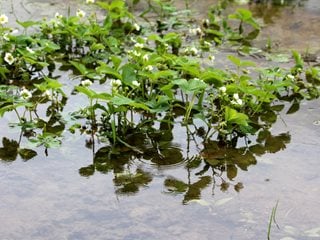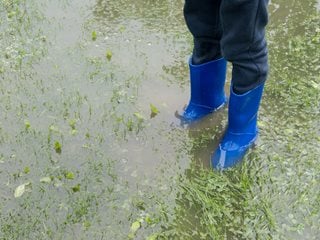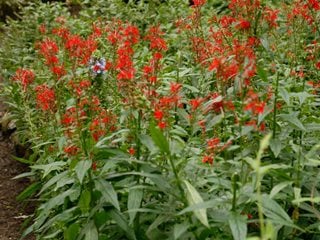Recovering a Flooded Garden: Dos & Don'ts
Save your plants from garden floods with these cleanup tips and preventative measuresWith a changing climate and an increase in extreme weather events such as hurricanes and heavy rain storms, more gardeners are being impacted by floods. A tidal surge due to a tropical storm or hurricane can cause widespread damage and leave toxic residue in garden soil and on plants. Pooled water from heavy downpours can also result in damage, though this type of flooding is less likely to cause contamination issues.
On this page:- EFFECTS OF FLOOD DAMAGE TO GARDENS
- WHAT TO DO IF YOUR GARDEN FLOODS
- CAN EDIBLE CROPS BE CONSUMED AFTER FLOODING?
- PREVENTATIVE MEASURES
EFFECTS OF FLOOD DAMAGE TO GARDENS
The amount of damage caused by garden floods will vary according to the amount of rainfall, depth of floodwaters, how long standing water remains, porosity of the soil, and property grade. Low-lying areas with poorly draining soil are more prone to flooding.
Standing water can lead to suffocation of plant roots and root rot, weakened plants, and susceptibility to pests and diseases. Symptoms of flood damage to plants include yellow, wilted or discolored foliage, leaf curl, defoliation, and plant dieback.
Most plants can survive waterlogged soil for short periods of time, though some plants are more resilient than others. Shallow-rooted annuals and food crops are most vulnerable. It may take a week or more to determine the extent of damage, though it’s crucial to act as soon as possible to remove floodwaters and save your plants.
WHAT TO DO IF YOUR GARDEN FLOODS
Drain excess water. As soon as it’s safe, remove excess water. Dig furrows, poke holes in the ground to aerate soil, or use a garden hose or pump to divert standing water away from garden areas.
Assess damage. Once the water recedes, walk around your yard to assess damage. Avoid walking on garden beds, which can further compact the soil, cutting off oxygen to the root zone.
Wear protective clothing. Storm surge floodwaters can contain chemicals, raw sewage, petroleum, and other pollutants. When working in contaminated areas, avoid direct contact with floodwaters and soil as much as possible. Wear rubber gloves, boots, and protective clothing. Wash hands thoroughly afterwards, and clean and disinfect protective clothing.
Avoid cross-contamination. If there are unflooded garden areas, avoid transporting tools, wheelbarrows and other equipment from contaminated areas to non-contaminated areas to prevent cross-contamination. Clean and sanitize contaminated equipment with a solution of 1 tbsp. bleach to 1 gallon of water.
Wash off plants. Rinse silt and mud off of plants. This is especially important with salt water, which can cause more damage to plants than fresh water.
Cover exposed roots. Erosion from floodwaters can wash away soil and expose plant roots. Cover up exposed roots with fresh garden soil.
Delay pruning. Hold off on pruning to allow defoliated branches to sprout new leaves. Prune limbs that are obviously broken, damaged or dead. Save major pruning for later to avoid further stress to plants.
Restore soil. Flooding causes erosion, depletion of nutrients, and drainage issues. Once the ground dries out, turn the soil and work in organic matter such as compost, leaf mulch, or manure to add nutrients, aerate the soil, and improve drainage. For vegetable beds, plant a cover crop in fall such as ryegrass, clover, or cowpea that will help control erosion, break up compacted soils, and add nutrients. Learn more about amending soil.
Delay replanting. Wait until garden areas have thoroughly dried out before replanting. For contaminated vegetable beds, wait at least 60 days before replanting edible crops.
CAN EDIBLE CROPS BE CONSUMED AFTER FLOODING?
Because of the risk of contamination from toxins, raw sewage, chemicals, heavy metals, and pathogens such as E. coli, salmonella, and listeria, garden produce that was touched by contaminated floodwaters should be discarded. This includes root crops such as beets, carrots, potatoes, and onions, and thick-skinned produce such as cantaloupe and watermelon.
Even if garden produce is not completely submerged, there still may be contamination from being in close proximity to floodwaters, from splashing on leaves or fruits, or from uptake of contaminated water through the root system. Mold, fungi, and other toxins may develop after waters recede. Safety should be assessed on a case-by-case basis.
Fruits and vegetables that develop from flowers produced after receding floodwaters should be safe to eat. Some produce from flooded gardens is more susceptible to contamination, including leafy vegetables such as lettuce, strawberries, tomatoes, squash, and peppers.
Rinse fruits and vegetables with tap water, and peel and cook before eating. Discard any produce with open fissures in the skin. Even if produce is washed and cooked, heavy metals and chemicals can still remain. Young children, pregnant women, the elderly, and those with compromised immune systems should avoid taking any risks.
Re-sow quick-maturing crops such as leafy greens in uncontaminated soil, or plant in raised beds or containers.
It’s best to contact your local extension service for advice on what is safe and unsafe to consume.
PREVENTATIVE MEASURES
If your area is prone to flooding or there’s a low-lying spot in your yard, there are ways to minimize damage to your landscape.
Fix drainage issues. If flooding is a chronic problem, build a swale or rain garden to catch excess water. Install a French drain or water pump to divert or remove water.
Add berms. Build berms around garden areas to divert excess water away from plants.
Keep gutters clean. Clogged gutters and downspouts can worsen flooding problems. Clean gutters regularly and keep them in good repair.
Add raised beds and containers. For chronically soggy areas, build raised beds or use containers to grow plants.
Plant a meadow garden. Many native plants have deep taproots that help break up the soil and draw rainwater into the ground more quickly. Learn more about how to create a meadow garden.
Include water-tolerant plants. Add trees, shrubs, and perennials to your landscape that are more tolerant to wet soil. These include bald cypress, cardinal flower, hibiscus, Joe pye weed, leopard plant, red osier dogwood, river birch, sweet gum, sweetspire, sycamore, and winterberry.
Improve soil. Clay soils drain more slowly compared to sandy or loamy soils. Adding organic matter will help clay soils to drain a bit faster as long as the grade is such that the entire area has somewhere to drain excess water to.
RELATED:
20+ Rain Garden Plants to Grow



